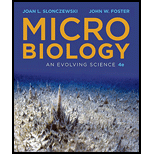
Microbiology: An Evolving Science (Fourth Edition)
4th Edition
ISBN: 9780393615098
Author: John W. Foster, Joan L. Slonczewski
Publisher: W. W. Norton & Company
expand_more
expand_more
format_list_bulleted
Question
Chapter 25, Problem 4RQ
Summary Introduction
To review:
Various portals of entry for infectious agents and diseases associated with each portal.
Introduction:
Diseases and infections are caused when the pathogens enter the body and overtake the immune system. These pathogens enter the body by direct and indirect means. There are several portals through which these pathogens can enter the body. The pathogens are generally microbes such as bacteria, viruses,
Expert Solution & Answer
Want to see the full answer?
Check out a sample textbook solution
Students have asked these similar questions
Define the term pathogen.
Using MRSA, NOROVIRUS, ATHLETES FOOT and MALARIA as examples, identify the microorganisms (causal agent) involved in each disease.
Provide some information on the microorganism for each disease e.g. structure
Discuss 3 routes of entry that disease causing organisms use to enter the body.
Define the term pathogen and identify causal agents for a range of infectious diseases involving, bacteria,viruses,fungi and protists
List three factors that contribute to the emergence of infectious diseases.
Chapter 25 Solutions
Microbiology: An Evolving Science (Fourth Edition)
Ch. 25.1 - Prob. 1TQCh. 25.4 - Prob. 1TQCh. 25.4 - Prob. 2TQCh. 25.4 - Prob. 3TQCh. 25.4 - Prob. 4TQCh. 25.5 - Prob. 1TQCh. 25.6 - Prob. 1TQCh. 25.6 - Prob. 2TQCh. 25.6 - Prob. 3TQCh. 25.6 - Prob. 4TQ
Ch. 25.7 - Prob. 1TQCh. 25 - Prob. 1RQCh. 25 - Prob. 2RQCh. 25 - Prob. 3RQCh. 25 - Prob. 4RQCh. 25 - Prob. 5RQCh. 25 - Prob. 6RQCh. 25 - Prob. 7RQCh. 25 - Prob. 8RQCh. 25 - Prob. 9RQCh. 25 - Prob. 10RQCh. 25 - Prob. 11RQCh. 25 - Prob. 12RQCh. 25 - Prob. 13RQCh. 25 - Prob. 14RQCh. 25 - Prob. 15RQCh. 25 - Prob. 16RQCh. 25 - Prob. 17RQCh. 25 - Prob. 1TQCh. 25 - Prob. 2TQCh. 25 - Prob. 3TQCh. 25 - Prob. 4TQCh. 25 - Prob. 5TQ
Knowledge Booster
Similar questions
- Distinguish between direct and indirect transmission of disease.Cite at least one example of eacharrow_forwardDescribe the four general mechanisms by which microorganisms cause disease.arrow_forwardDescribe the characteristics of infectious diseases, including the course of disease, duration of symptoms, and distribution of the pathogen.arrow_forward
- Use key terms to describe different patterns of infection.arrow_forwardDescribe the chain of transmission of communicable diseases and explain how infectious agents are transmitted by direct and indirect modes (Answer in 800 words)arrow_forwardWhat is epidemiology? there are several ways pathogens can be transmitted including direct contact, indirect contact, via respiratory droplets, vehicle, and through a vector. Describe each mode IN DETAIL and give an example of a pathogen that can be transmitted each way.arrow_forward
- Describe the difference between the terms INFECTION and DISEASE. Starting with exposure to pathogens, describe IN DETAIL the steps involved in the infection process ( exposure, adherence, invasion and multiplication) as well as the disease process( Toxicity, invasiveness, tissue or system damage)arrow_forwardAll of the following are requirements for being a "carrier" of an infection, except: a. Active multiplication of the infectious agent in the body b. Absence of recognizable symptoms and signs of the infection c. Presence of the infectious agent in the body d. Ability to transmit the infection through excretions, discharges, and/or respiratory dropletsarrow_forwardExplain how specialized structures (e.g., spore, capsule, fimbriae, or flagella) enable a microbe to survive in a given environment or contribute to pathogenesis.arrow_forward
- Describe the factors that contribute to the emergence or re-emergence of disease.arrow_forwardDescribe the infectious disease processarrow_forwardExplain what is happening during each stage of infection. Compare and contrast: systemic, local, and focal infections; primary versus secondary infections; infection versus intoxication.arrow_forward
arrow_back_ios
SEE MORE QUESTIONS
arrow_forward_ios
Recommended textbooks for you
 Human Anatomy & Physiology (11th Edition)BiologyISBN:9780134580999Author:Elaine N. Marieb, Katja N. HoehnPublisher:PEARSON
Human Anatomy & Physiology (11th Edition)BiologyISBN:9780134580999Author:Elaine N. Marieb, Katja N. HoehnPublisher:PEARSON Biology 2eBiologyISBN:9781947172517Author:Matthew Douglas, Jung Choi, Mary Ann ClarkPublisher:OpenStax
Biology 2eBiologyISBN:9781947172517Author:Matthew Douglas, Jung Choi, Mary Ann ClarkPublisher:OpenStax Anatomy & PhysiologyBiologyISBN:9781259398629Author:McKinley, Michael P., O'loughlin, Valerie Dean, Bidle, Theresa StouterPublisher:Mcgraw Hill Education,
Anatomy & PhysiologyBiologyISBN:9781259398629Author:McKinley, Michael P., O'loughlin, Valerie Dean, Bidle, Theresa StouterPublisher:Mcgraw Hill Education, Molecular Biology of the Cell (Sixth Edition)BiologyISBN:9780815344322Author:Bruce Alberts, Alexander D. Johnson, Julian Lewis, David Morgan, Martin Raff, Keith Roberts, Peter WalterPublisher:W. W. Norton & Company
Molecular Biology of the Cell (Sixth Edition)BiologyISBN:9780815344322Author:Bruce Alberts, Alexander D. Johnson, Julian Lewis, David Morgan, Martin Raff, Keith Roberts, Peter WalterPublisher:W. W. Norton & Company Laboratory Manual For Human Anatomy & PhysiologyBiologyISBN:9781260159363Author:Martin, Terry R., Prentice-craver, CynthiaPublisher:McGraw-Hill Publishing Co.
Laboratory Manual For Human Anatomy & PhysiologyBiologyISBN:9781260159363Author:Martin, Terry R., Prentice-craver, CynthiaPublisher:McGraw-Hill Publishing Co. Inquiry Into Life (16th Edition)BiologyISBN:9781260231700Author:Sylvia S. Mader, Michael WindelspechtPublisher:McGraw Hill Education
Inquiry Into Life (16th Edition)BiologyISBN:9781260231700Author:Sylvia S. Mader, Michael WindelspechtPublisher:McGraw Hill Education

Human Anatomy & Physiology (11th Edition)
Biology
ISBN:9780134580999
Author:Elaine N. Marieb, Katja N. Hoehn
Publisher:PEARSON

Biology 2e
Biology
ISBN:9781947172517
Author:Matthew Douglas, Jung Choi, Mary Ann Clark
Publisher:OpenStax

Anatomy & Physiology
Biology
ISBN:9781259398629
Author:McKinley, Michael P., O'loughlin, Valerie Dean, Bidle, Theresa Stouter
Publisher:Mcgraw Hill Education,

Molecular Biology of the Cell (Sixth Edition)
Biology
ISBN:9780815344322
Author:Bruce Alberts, Alexander D. Johnson, Julian Lewis, David Morgan, Martin Raff, Keith Roberts, Peter Walter
Publisher:W. W. Norton & Company

Laboratory Manual For Human Anatomy & Physiology
Biology
ISBN:9781260159363
Author:Martin, Terry R., Prentice-craver, Cynthia
Publisher:McGraw-Hill Publishing Co.

Inquiry Into Life (16th Edition)
Biology
ISBN:9781260231700
Author:Sylvia S. Mader, Michael Windelspecht
Publisher:McGraw Hill Education